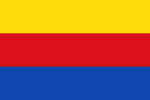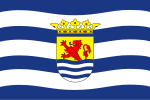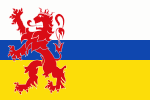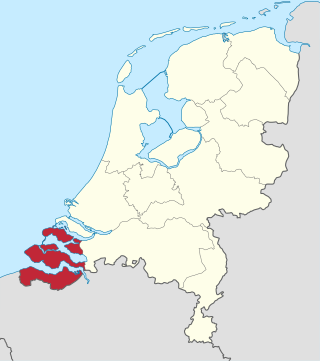
Zeeland is the westernmost and least populous province of the Netherlands. The province, located in the southwest of the country, borders North Brabant to the east, South Holland to the north, as well as the country of Belgium to the south and west. It consists of a number of islands and peninsulas and a strip bordering the Flemish provinces of East and West Flanders. Its capital is Middelburg with a population of 48,544 as of November 2019, although the largest municipality in Zeeland is Terneuzen. Zeeland has two seaports: Vlissingen and Terneuzen. Its area is 2,933 square kilometres (1,132 sq mi), of which 1,154 square kilometres (446 sq mi) is water; it had a population of about 391,000 as of January 2023.
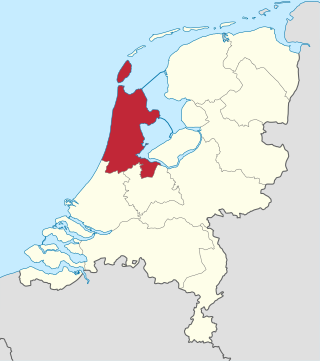
North Holland is a province of the Netherlands in the northwestern part of the country. It is located on the North Sea, north of South Holland and Utrecht, and west of Friesland and Flevoland. As of January 2023, it had a population of about 2,952,000 and a total area of 4,092 km2 (1,580 sq mi), of which 1,429 km2 (552 sq mi) is water.

There are twelve provinces of the Netherlands representing the administrative layer between the national government and the local governments, with responsibility for matters of subnational or regional importance.

The flag of North Brabant consists of a chequy pattern with 24 distinct fields in the colours red and white or gules and argent. The flag has been used since the Middle Ages, but fell into disuse in the 18th century. The flag is now back in use, and has been the official flag of North Brabant since 1959.
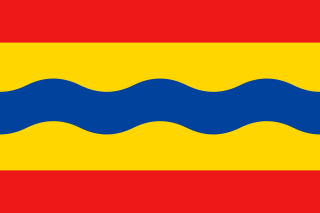
The flag of Overijssel is the official flag of the province of Overijssel. The flag consists of two red and yellow stripes along with a blue wave in the middle. It was adopted on 21 July 1948. The current flag is the only one the province has ever had. The yellow and red stripes on the flag are supposed to represent the historical link with the province of Holland. The three colours are, namely, the colours of the coat of arms of Overijssel. In the centre of the flag, the wavy blue line represents the river IJssel, after which the province is named.

The flag of Zeeland was adopted on 14 January 1949. The crown and shield of the coat of arms of Zeeland occupy a prominent place on the Zeelandic flag. These symbols are surrounded by wavy stripes in the colours blue and white. The blue stripes symbolize the constant battle against water, an important element of Zeelandic history and identity. The coat of arms consists of a lion wrestling with the waves. The upper half shows a 'climbing lion', half depicted. The lower half shows six wavy stripes, 'the sea'. The whole thing wrongly suggests a lion fighting the raging waves. In the past, there was actually no such thing. In fact, in the old coat of arms, the lion and waves were separated by a clean line. The flag of Zeeland was designed in 1948 and was declared a provincial flag in 1949. This flag was designed by Tjalling Aedo Johan Willem Schorer.
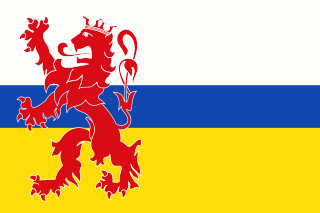
The flag of Limburg is a flag with the ratio of approximately 1:2. It consists of 3 rows of colors in a size ratio of 2:1:2. The colors used are white, blue and gold (yellow). The flag was adopted by decree of the provincial executive of Limburg on 28 July 1953.

The Royal Dutch Hockey Association is the official governing body of Field hockey in the Netherlands. It governs both the indoor and outdoor field hockey leagues, as well as the Netherlands national field hockey team and the Netherlands women's national field hockey team.
The Netherlands has several levels of administrative subdivisions. The first level of subdivision consists of 12 provinces. The second level of subdivision consists of 342 municipalities.

The flag of South Holland was adopted on 24 October 1985, replacing the flag used since 22 June 1948. The flag shows a red lion standing out prominently against an even yellow background. The flag of the most populous province is a banner of arms of the South Holland coat of arms. This shield is in turn grafted onto the coat of arms of Holland. The colour choice is also obvious; after all, yellow and red have traditionally been the colours of the province of Holland. Remarkably, the aspect ratio of the South Holland flag is 2:3, the same dimensions that also apply to the national tricolour. The left-facing lion, standing on its hind legs, occupies three-quarters of the flag's height and is equally distant from the top and bottom. The colours red and yellow are Holland's traditional colours and are also found of the flag of North Holland.
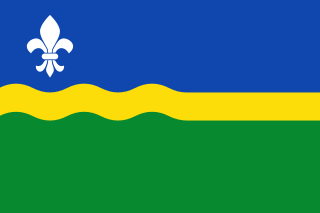
The flag of Flevoland was hoisted for the first time on 9 January 1986, and it was formally defined as the provincial flag on 15 February 1989.

The provincial council, also known as the States-Provincial, is the provincial parliament and legislative assembly in each of the provinces of the Netherlands. It is elected for each province simultaneously once every four years and has the responsibility for matters of sub-national or regional importance. The number of seats in a provincial council is proportional to its population.
Dutch dialects are primarily the dialects that are both cognate with the Dutch language and spoken in the same language area as the Dutch standard language. They are remarkably diverse and are found within Europe mainly in the Netherlands and northern Belgium.
The Dutch Amateur Radio Emergency Service (DARES), which was founded on 12 May 2004, is a non-profit organization made out of licensed radio amateurs in the Netherlands. DARES participants are able to set up a national, continental or international radio network in case of an emergency situation, like a power outage on a large scale, a flooding, a cyber attack causing severe damage to communication networks, or other emergency situations, where the safety of a large group of people are in danger.

Provincial elections were held in the Netherlands on 20 March 2019. Eligible voters elected the members of the Provincial States in the twelve provinces of the Netherlands. The elections were held on the same day as the 2019 Dutch water boards elections and, in the Caribbean Netherlands, island council elections.

Miss Grand Netherlands 2023 was the fourth edition of the Miss Grand Netherlands beauty pageant, held on June 4, 2023, at the Claus Event Center in the city of Hoofddorp. Eleven candidates, who qualified for the national stage through an audion held in February and then were assigned to represents one of the country's provinces, competed for the title.

The Regio Songfestival is a Dutch song competition between regional public broadcasters. Held in its current form since 2023, the format of the competition is loosely based on the Eurovision Song Contest and was first used in 1995 under its original title Het Nederlandse Songfestival. Every edition features thirteen original songs that are performed in a live broadcast, each representing a region of the Netherlands. From the competing entries, a winner is determined through a combination of televoting and votes cast by regional juries.














